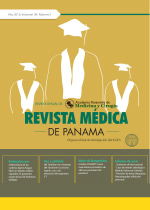DIAGNÓSTICO DEL REFLUJO LARINGO-FARÍNGEO: ENDOSCOPIA LARÍNGEA vs PHMETRÍA
Autores/as
DOI:
https://doi.org/10.37980/im.journal.rmdp.2014146Resumen
INTRODUCIÓN: El Reflujo laringofaríngeo es una variante extra esofágica de la enfermedad de reflujo gastroesofágico. Es el síndrome extra esofágico más extensamente estudiado. Se define como el reflujo de contenido gástrico hacia la laringe y faringe. Se trata de un diagnóstico desafiante, ya que sus signos y síntomas son generalmente inespecíficos y no existen signos patognomónicos. OBJETIVOS: Este estudio tiene como objetivo correlacionar manifestaciones otorrinolaringológicas del RLF con hallazgos en la nasolaringoscopia y pHmetría. MÉTODOS: Fueron evaluados expedientes de pacientes con síntomas otorrinolaringológicos y nasofibrolaringoscopia sugestiva de RLF, con endoscopia digestiva alta normal y que posteriormente fueron sometidos a pHmetría. RESULTADOS: 33 pacientes fueron evaluados con edad media de 29.18 años variando entre 3 y 79 años. Se observó relación entre los hallazgos en la nasofibrolaringoscopia y valores patológicos del índice de Demeester. CONCLUSIÓN: Se concluye que mientras más intensos los signos en la endoscopia laríngea, mayor será el grado de positividad en la pHmetría.
Diagnosis of laryngeal-pharyngeal reflux: laryngeal endoscopy vs. pHmetry
ABSTRACT
BACKGROUND: The laryngopharyngeal reflux is an extra- esophageal variant of gastroesophageal reflux disease. This is the most extensively investigated extra-esophageal syndrome. It is defined as the reflux of gastric contents into the larynx and pharynx. The laryngeal symptoms and signs of laryngopharyngeal reflux are generally non-specific and there are not pathonomonic laryngoscopic signs. GOALS: This study aims to correlate ear nose and throat manifestations of laryngopharyngeal reflux with nasofibrolaryngoscopy findings and esophageal pH monitoring. METHODS: Retrospective study of medical records of patients with ear-nose and throat symptoms and nasofibroscopy suggestive of laryngopharyngeal reflux with normal digestive endoscopy that underwent subsequent pH monitoring. RESULTS: 33 medical records were found with a mean age of 29.18 years old ranging from 3 to 79 years old. A close relationship between nasofibrolaryngoscopy findings and pathological values of the De Meester index. CONCLUSION: We conclude that the more intense signals of laryngoscopy, the greater its degree of positivity in the pH monitoring.
Key Word: Reflux laryngopharyngeal, pH monitoring, Nasolaryngoscopy
Publicado
Número
Sección
Licencia
Derechos autoriales y de reproducibilidad. La Revista Médica de Panama es un ente académico, sin fines de lucro, que forma parte de la Academia Panameña de Medicina y Cirugía. Sus publicaciones son de tipo acceso gratuito de su contenido para uso individual y académico, sin restricción. Los derechos autoriales de cada artículo son retenidos por sus autores. Al Publicar en la Revista, el autor otorga Licencia permanente, exclusiva, e irrevocable a la Sociedad para la edición del manuscrito, y otorga a la empresa editorial, Infomedic International Licencia de uso de distribución, indexación y comercial exclusiva, permanente e irrevocable de su contenido y para la generación de productos y servicios derivados del mismo. En caso que el autor obtenga la licencia CC BY, el artículo y sus derivados son de libre acceso y distribución.






